Content for TS 23.003 Word version: 18.6.0
1…
2…
2.8…
3…
4…
5…
6…
7…
8…
9…
10…
11
12…
13…
14…
15…
16…
17…
18…
19…
19.4…
19.5…
20…
21…
22…
23…
24…
25…
26…
27…
28…
28.3.2.2…
28.3.2.2.6…
28.3.2.3…
28.4…
28.7…
28.8…
29…
A…
B…
C…
D
E…
4 Identification of location areas and base stations
4.1 Composition of the Location Area Identification (LAI)
4.2 Composition of the Routing Area Identification (RAI)
4.3 Base station identification
4.3.1 Cell Identity (CI) and Cell Global Identification (CGI)
4.3.2 Base Station Identify Code (BSIC)
4.4 Regional Subscription Zone Identity (RSZI)
4.5 Location Number
4.6 Composition of the Service Area Identification (SAI)
4.7 Closed Subscriber Group
4.8 HNB Name
4.9 CSG Type
4.10 HNB Unique Identity
4.11 HRNN
...
...
4 Identification of location areas and base stations p. 35
4.1 Composition of the Location Area Identification (LAI) p. 35
The Location Area Identification shall be composed as shown in Figure 3:
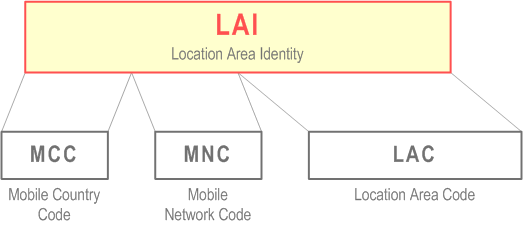
The LAI is composed of the following elements:
- Mobile Country Code (MCC) identifies the country in which the GSM PLMN is located. The value of the MCC is the same as the three digit MCC contained in international mobile subscriber identity (IMSI);
- Mobile Network Code (MNC) is a code identifying the GSM PLMN in that country. The MNC takes the same value as the two or three digit MNC contained in IMSI;
-
Location Area Code (LAC) is a fixed length code (of 2 octets) identifying a location area within a PLMN. This part of the location area identification can be coded using a full hexadecimal representation except for the following reserved hexadecimal values:
- 0000, and
- FFFE.
4.2 Composition of the Routing Area Identification (RAI) p. 35
The Routing Area Identification shall be composed as shown in Figure 4:
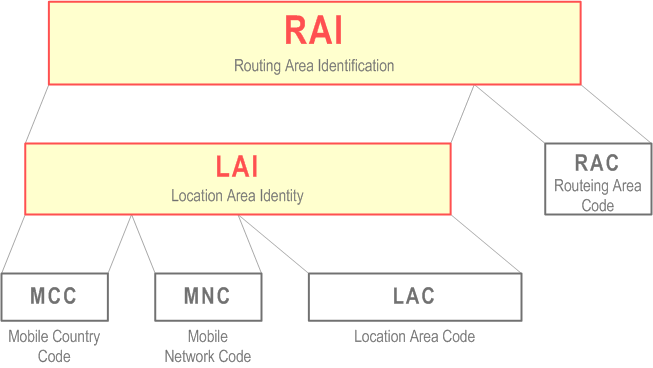
The RAI is composed of the following elements:
- A valid Location Area Identity (LAI) as defined in clause 4.1. Invalid LAI values are used in some special cases when no valid RAI exists in the mobile station (see TS 24.008, TS 31.102 and TS 51.011).
- Routeing Area Code (RAC) which is a fixed length code (of 1 octet) identifying a routeing area within a location area.
4.3 Base station identification p. 35
4.3.1 Cell Identity (CI) and Cell Global Identification (CGI) p. 35
The BSS and cell within the BSS are identified within a location area or routeing area by adding a Cell Identity (CI) to the location area or routeing area identification, as shown in Figure 5. The CI is of fixed length with 2 octets and it can be coded using a full hexadecimal representation.
The Cell Global Identification is the concatenation of the Location Area Identification and the Cell Identity. Cell Identity shall be unique within a location area.
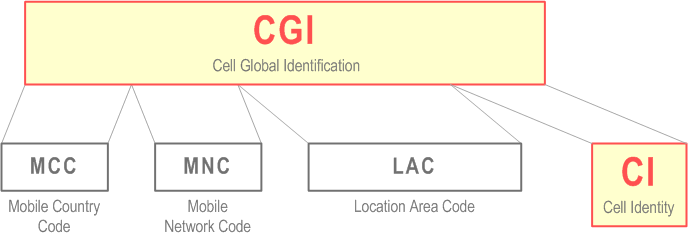
4.3.2 Base Station Identify Code (BSIC) p. 36
The base station identity code is a local colour code that allows an MS to distinguish between different neighbouring base stations. BSIC is a 6 bit code which is structured as shown in Figure 6. Exceptions apply to networks supporting EC-GSM-IoT or PEO and for mobile stations in EC or PEO operation (see TS 43.064) where the BSIC is a 9 bit code which is structured as shown in Figure 6a.
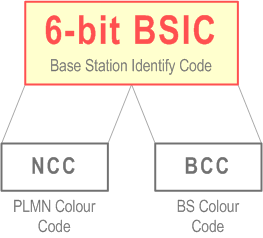
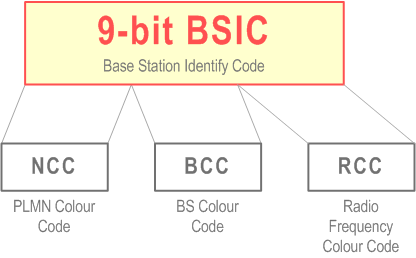
In the definition of the NCC, care should be taken to ensure that the same NCC is not used in adjacent PLMNs which may use the same BCCH carrier frequencies in neighbouring areas. Therefore, to prevent potential deadlocks, a definition of the NCC appears in Annex A. This Annex will be reviewed in a co-ordinated manner when a PLMN is created.
In addition to the above, the GERAN networks should be configured so that:
- in a cell shared between different PLMNs as per GERAN network sharing (see TS 44.018 and TS 44.060), the NCC used in this cell is different from the NCC used in the neighbouring non-shared cells of these PLMNs; and that
- these PLMNs use different NCCs in non-shared cells neighbouring this shared cell.
4.4 Regional Subscription Zone Identity (RSZI) p. 37
A PLMN-specific regional subscription defines unambiguously for the entire PLMN the regions in which roaming is allowed. It consists of one or more regional subscription zones. The regional subscription zone is identified by a Regional Subscription Zone Identity (RSZI). A regional subscription zone identity is composed as shown in Figure 7.
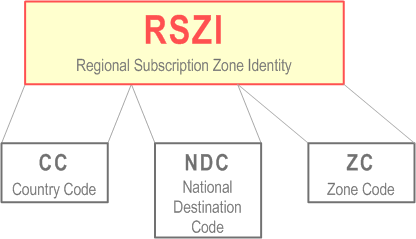
The elements of the regional subscription zone identity are:
- the Country Code (CC) which identifies the country in which the PLMN is located;
- the National Destination Code (NDC) which identifies the PLMN in that country;
- the Zone Code (ZC) which identifies a regional subscription zone as a pattern of allowed and not allowed location areas uniquely within that PLMN.
4.5 Location Number p. 37
A location number is a number which defines a specific location within a PLMN. The location number is formatted according to ITU-T Recommendation E.164, as shown in Figure 8. The Country Code (CC) and National Destination Code (NDC) fields of the location number are those which define the PLMN of which the location is part.
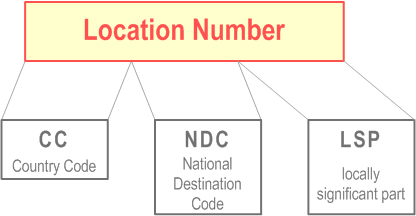
The structure of the locally significant part (LSP) of the location number is a matter for agreement between the PLMN operator and the national numbering plan administrator in the PLMN's country. It is desirable that the location number can be interpreted without the need for detailed knowledge of the internal structure of the PLMN; the LSP should therefore include the national destination code in the national numbering plan for the fixed network which defines the geographic area in which the location lies.
The set of location numbers for a PLMN shall be chosen so that a location number can be distinguished from the MSISDN of a subscriber of the PLMN. This will allow the PLMN to trap attempts by users to dial a location number.
4.6 Composition of the Service Area Identification (SAI) p. 38
Void (see clause 12.5).
4.7 Closed Subscriber Group |R8| p. 38
A Closed Subscriber Group consists of a single cell or a collection of cells within an E-UTRAN and UTRAN that are open to only a certain group of subscribers.
Within a PLMN, a Closed Subscriber Group is identified by a Closed Subscriber Group Identity (CSG-ID). The CSG-ID shall be fix length 27 bit value.
4.8 HNB Name |R8| p. 38
HNB Name shall be a broadcast string in free text format that provides a human readable name for the Home NodeB or Home eNodeB CSG identity.
HNB Name shall be coded in UTF-8 format with variable number of bytes per character. The maximum length of HNB Name shall be 48 bytes.
See TS 22.011 for details.
4.9 CSG Type |R8| p. 38
CSG Type shall provide the type of a CSG identity in a human readable form. It shall reside in the UE only. See TS 22.011 for details.
When the CSG Type has a text component, the CSG Type shall be coded in UTF-8 format with variable number of bytes per character . The maximum text length shall not exceed 12 characters in any language.
4.10 HNB Unique Identity |R9| p. 38
HNB Unique Identity uniquely identifies a Home NodeB or Home eNodeB.
The HNB unique identity shall be defined as either a 48-bit or 64-bit extended unique identifier (EUI-48 or EUI-64) as defined in [85] (EUI-48) and [86] (EUI-64).
For use in HNB certificates, the HNB Unique Identity shall be transformed into a FQDN in the form:
- <EUI-48/64>.<REALM>